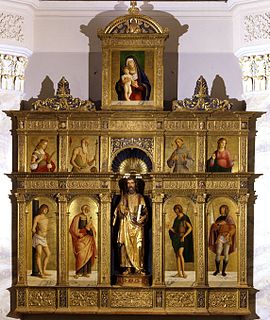The Madonna and Child with Saints is the subject of several paintings by Cima da Conegliano:

BartolomeoMontagna was an Italian Renaissance painter who mainly worked in Vicenza. He also produced works in Venice, Verona, and Padua. He is most famous for his many Madonnas and his works are known for their soft figures and depiction of eccentric marble architecture. He is considered to be heavily influenced by Giovanni Bellini, in whose workshop he might have worked around 1470. Benedetto Montagna, a productive engraver, was his son and pupil and active until about 1540. He was mentioned in Vasari's Lives as a student of Andrea Mantegna but this is widely contested by art historians.

Carlo Crivelli was an Italian Renaissance painter of conservative Late Gothic decorative sensibility, who spent his early years in the Veneto, where he absorbed influences from the Vivarini, Squarcione, and Mantegna. He left the Veneto by 1458 and spent most of the remainder of his career in the March of Ancona, where he developed a distinctive personal style that contrasts with that of his Venetian contemporary Giovanni Bellini.

Giovanni Battista Cima, also called Cima da Conegliano, was an Italian Renaissance painter, who mostly worked in Venice. He can be considered part of the Venetian school, though he was also influenced by Antonello da Messina, in the emphasis he gives to landscape backgrounds and the tranquil atmosphere of his works. Once formed his style did not change greatly. He mostly painted religious subjects, often on a small scale for homes rather than churches, but also a few, mostly small, mythological ones.
Bernardo Castello (1557–1629) was an Italian painter of the late-Mannerist style, active mainly in Genoa and Liguria. He is mainly known as a portrait and historical painter.
Marco Palmezzano (1460–1539) was an Italian painter and architect, belonging to the Forlì painting school, who painted in a style recalling earlier Northern Renaissance models. He was mostly active near Forlì.

Francesco Beccaruzzi was an Italian painter of the Renaissance era, active near his hometown of Conegliano and in the neighborhood of Treviso. He was influenced by both Il Pordenone and later Titian. He painted Saint Francis receiving stigmata (1545) from Conegliano, but now in the Gallerie dell'Accademia in Venice.
Events from the year 1516 in art.
The decade of the 1450s in art involved many significant events, especially in sculpture.

The Madonna and Child with Six Saints, also known as Sant'Ambrogio Altarpiece, is a painting by the Italian Renaissance master Sandro Botticelli, finished around 1470. It is housed in the Galleria degli Uffizi, in Florence.

The Madonna dell'Orto is a church in Venice, Italy, in the sestiere of Cannaregio.

Giampietrino, probably Giovanni Pietro Rizzoli, was a north Italian painter of the Lombard school and Leonardo's circle, succinctly characterized by S. J. Freedberg as an "exploiter of Leonardo's repertory."
The Catalogue of paintings in the National Gallery, London is the collection catalog listing the paintings of the National Gallery, London collection, as they were catalogued in 2010 by the Public Catalogue Foundation. The collection contains roughly 2,300 paintings by 750 artists, and only attributed artists are listed here. Painters with more than twenty works in the collection are Jean-Baptiste-Camille Corot, Carlo Crivelli, Anthony van Dyck, Francesco Guardi, Rembrandt van Rijn, Peter Paul Rubens, Jacob van Ruisdael, and David Teniers II. The only women artists with works in the collection are Artemisia Gentileschi, Marie Blancour, Rosa Bonheur, Rosalba Giovanna Carriera, Catharina van Hemessen, Judith Leyster, Rachel Ruysch, and Elisabeth Louise Vigée-LeBrun. The only British artists with works in the collection are William Boxall, John Constable, Thomas Gainsborough, William Hogarth, John Hoppner, John Callcott Horsley, John Jackson, Thomas Jones, Cornelis Janssens van Ceulen, Thomas Lawrence, John Linnell, Henry Raeburn, Joshua Reynolds, Martin Archer Shee, George Stubbs, Joseph Mallord William Turner, Richard Wilson, and Joseph Wright of Derby. However, because of the historical links between the National Gallery and its offshoot in the 19th century, Tate Britain, the National has in the past transferred and recalled works by British artists to and from its collection.

The Polyptych of Miglionico is a large, multicompartment Renaissance-style altarpiece painted in 1499 by Cima da Conegliano and housed in the church of Santa Maria Maggiore in the town of Miglionico, province of Matera, Basilicata, Italy.

Olera Altarpiece is an oil on panel nine-panel altarpiece by Cima da Conegliano, created c. 1486–1488, housed in the parish church in Olera.

The Conegliano Altarpiece or Madonna and Child with Angels and Saints is an oil painting produced in 1492 by Cima da Conegliano as the high altarpiece for the Duomo di Conegliano in his birthplace.
Madonna and Child with Saints is a common theme in Christian art, and is thus the title of a number of works.

Madonna and Child Enthroned with Saint James and Saint Jerome is a 1489 oil painting by Cima da Conegliano, originally painted on panel and later transferred to canvas. It shows James the Great and Jerome either side of an enthroned Madonna and Child and now hangs in the Pinacoteca civica in Vicenza, housed in the Palazzo Chiericati.

The Sacred Conversation or Madonna and Child Enthroned with praying brothers and devotees, Saint Sebastian, Saint John the Baptist, Saint Mary Magdalene and Saint Roch is a 1490 oil on panel painting by Cima da Conegliano, now in the Pinacoteca di Brera in Milan.